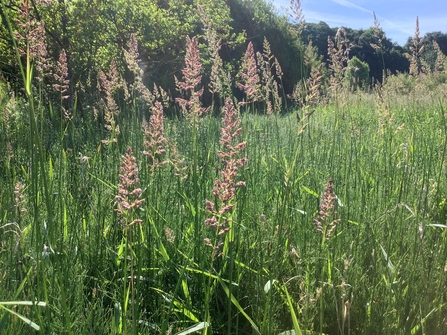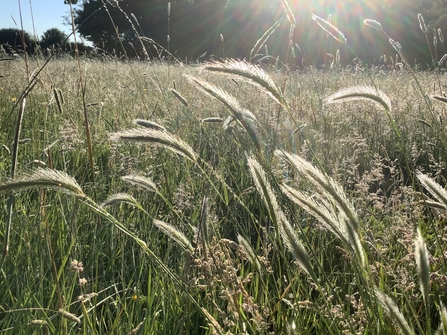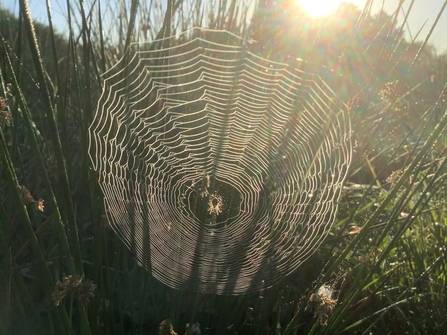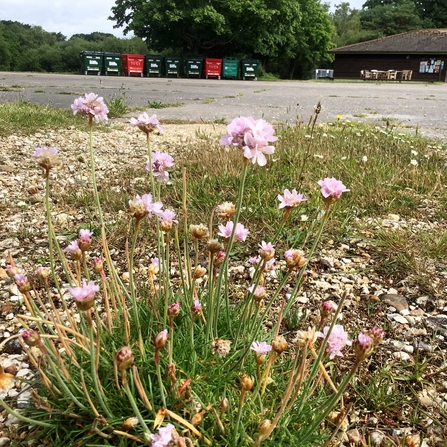Clive Chatters is a naturalist and nature conservationist who enjoys writing and teaching. He's currently the company secretary of Hampshire & Isle of Wight Wildlife Trust. Every year Clive participates in 30 Days Wild and we're honoured that he's returned to share his wonderful anecdotes with us.
The Biter Bit
On Saturday morning I was at Testwood Lakes Nature Reserve watching my first marbled white butterflies of the year. They were flitting around the oxeye daisies by the car park, only moving on when a hornet arrived.
Hornets are mighty creatures, huge, strong and confident in themselves. There is none of the worry that I associate with smaller wasps; as long as you respect the hornet, they will leave you be. This particular creature was behaving in a way I hadn’t seen before; it went from flower to flower, sometimes unravelling closed-up petals but was not feeding on pollen. In time my attention wandered onto something else, I forget what.
After a few minutes I saw the hornet again, this time engrossed with something in its jaws. Getting closer, I could see that it was dismembering a crab spider, clearly the earlier search of daisies had been in pursuit of this stealth predator. Crab spiders hunt by lying in wait within a flower, relying on camouflage and quick reactions to capture pollinating insects. Later the same day, my wife Catherine and I visited Butterfly Conservation’s Magdalen Hill Down where there was a crab spider which had captured a marbled white. In Catherine’s picture you can see the spider paralysing its prey, untroubled by being predated upon itself.
© Catherin Chatters
Festival Time
This weekend brings the Isle of Wight festival with all the fun that the Island has to offer. The ferries are never busier and that brings an opportunity to enjoy nature.
Traffic builds up for the Lymington ferry as far back as the causeway across the Lymington river. If you're stuck there, then take a look out of the window at the Ivy clad verge. Amongst the prostrate ivy leaves are curious flowers on erect stems, the colour of old bruises. They grow amongst last season's detritus, but once you look at them more closely, there are dozens of them. This is a broomrape, a parasite that has no green parts and relies on tapping into ivy roots for its energy. The Island is a national stronghold for broomrapes and this is one of the most common. The traffic will move on, eventually, so you might as well enjoy your enforced immobility.

© Clive Chatters
Walking through grasslands
The reed canary grass is in full flower. Pushing my way through its head-high stands generates clouds of pollen, making me glad I don't suffer from hayfever. It is nearly 9 o'clock - the sun rose nearly five hours ago and the day is warming up. As well as being full of pollen, the air teems with insects, mostly benign but some which see me as an opportunity. Biting flies are difficult to like.
These tall grasslands and swamps are home to roe deer. Earlier today there were three bucks asserting themselves from scattered vantage points. Their call is something between a grunt and a bark- puzzling until you realise what it is. Yesterday one fine specimen stood its ground as I approached, its antlers still coated in fine velvet. The rutting season is not quite upon us.
I'm told these fields were part of a dairy farm which closed 25 years ago. The land is so wet and distanced from other enterprises it has been left to its own devises. The result is beautiful, but as the temperature rises, the habitat is a little uncomfortable to work through.

© Clive Chatters
Apricity
Apricity is one of those great words which captures a feeling - the sensation of the heat of the sun but a chill in the air. This morning the air was distinctly cold, but as soon as the sun rose it had real heat. It was a sensible choice to start work early.
The river runs at a fairly constant temperature, so at dawn it is warmer than the air, giving off a ribbon of mist across the meadows. When the sun first hits this vapour it sends off rainbow hues, an effect that is all too fleeting. The dew takes longer to clear, which is to my advantage. The fine whiskers of meadow barley mean it is one of the last grasses to cast off the dew, so giving me a chance to spot its distribution across a huge floodplain meadow, without needing to trample the hay crop.

© Clive Chatters
An early start
Yesterday morning was an early start, onsite at dawn with all the rewards that brings. Young lapwings running around to the sound of a nightingale. I would have thought it a little late for this songster, but I was serenaded for a good hour.
This week finds me surveying a stretch of river in the Sussex low weald. The valley floods most winters so the farming dominated by cattle grazing with a little hay. This can make life exciting - I've made friends with some boisterous bullocks and respectfully gave some distance to cautiously maternal cows with calves.
Before the sun is fully up, every surface seems covered in cobwebs, revealed by the dew. This splendid orbweb spider seems to be a free spirit in the construction of its web. If you look carefully, it riffs on the traditional pattern with all sorts of variations.

© Clive Chatters
Judgements
Solomon’s Seal is one of the treats of spring, a graceful woodlander with delicate hanging stems, ladder-like leaves and pendulous creamy flowers which display its affiliation to the lily family. In the wild the ‘common’ Solomon’s seal, Polygonatum multiflorum, is widespread in the chalk woodlands of central Hampshire, but is confined to a single site on the Isle of Wight. Such are the puzzles of plant distribution. I grow two types in the garden, the classic gardeners’ hybrid Polygonatum x hybridum- a lovely thing, along with a much stumpier native Polygonatum odoratum, the Angular Solomons Seal, which is a great rarity of species-rich bracken beds on the New Forest. My plants once grew on the heathland ridge of what is now the A31- the dual carriageway which crosses the Forest. The roots were salvaged from the path of the tarmacers by John Lavender, the much-missed curator of the Red House Museum in Christchurch.
Each year, when the stems of the garden hybrids are at their most gorgeous, they are visited by tiny sawflies, dark insects that look a little like flying ants. Sawflies get their name from the saw-like appendages with which they insert their eggs into the stems of host plants. By mid-June these eggs have hatched into a hoard of larvae that can defoliate a plant in a few days. This happens every year - at first I disliked the little grubs intensely, now I’m more inclined to live and let live. Interestingly, the Angular Solomons Seal is entirely ignored by the Sawfly. Would I be as tolerant should their attention be directed to my precious pot of this local rarity?
© Clive Chatters
Thrifty money
Readers of a certain age will remember thrift as the wildflower which graced the Thruppenny Bit, a piece of small change from the pre-decimal era. I distinctly recall using this 12-sided coin and trying to master our teacher’s instructions that as a unit of currency, four thruppences made a shilling, 8 made a two-bob bit (or a florin to the smart set), 10 made a half crown, 80 made a pound and 84 made a guinea. The changes of 15th February 1971 could not come soon enough and were much heralded by jolly educational songs by The Scaffold, “Decimal point is small and round, decimal point is funny, it divides the pence from pounds, when you count in money”.
As a native wildflower, thrift is usually found on mountain tops and along the coast. What those habitats have in common is that they are highly stressed, thrift does well where many other species struggle to survive. Occasionally, an odd plant turns up unexpectedly, such as I found yesterday in the gateway of a caravan park, just around the back of the bins. I enjoy such finds as they are curiosities, not ‘important’ in the scientific sense, just another example of nature doing something wonderfully unpredictable. They also make a pleasant diversion from the whiff of warm summer dustbins.

© Clive Chatters
Cool Bucks
Yesterday my work took me to Ocknell Plain on the New Forest, to survey some rather worryingly invasive non-native plants. I’m a great believer in walking into a site rather than driving: you never know what you’ll find en route, and it gives you context and time to think. The last stretches of the old concrete runways, built at Ocknell for RAF Stoney Cross, were removed some 30 years ago, and have healed over beautifully. Constant grazing and browsing by forest animals has prevented coarse species from becoming dominant and today it is superbly flowery was great swathes of wild thyme, fairy flax and even the occasional bee orchid. One could compare it with a chalk grassland, but it is much richer in the range of species it supports.
After hours of botanical footslogging, I headed back to the car, which I’d left near an ice cream van for security. A small herd of Fallow deer were grazing happily on the plain requiring me to take a detour so not to disturb them. The best view I usually get of deer is of bobbing tails in the distance- this gathering of young bucks was extraordinary in their tolerance to people.
© Clive Chatters
Food is for sharing.
Some years ago, nasturtiums established themselves as a persistent ‘weed’ in my vegetable patch. They are pretty enough in flower, but at this time of year their disc-shaped leaves can overwhelm small seedlings of beetroot and coriander. Young nasturtium leaves are great at cheering up a lettuce salad with a spicy tang. So, the ‘weed’ is now welcomed as an informal crop, at least until it becomes a nuisance. We are not alone in appreciating the fresh foliage: Large White Butterflies home in on the youngest plants to lay their eggs. Once hatched, the caterpillars will eat through the Nasturtiums faster than we do.
All this means is, at this time of year, the job of picking a salad takes just a little bit longer. Each leaf is turned over to check for eggs, clusters of a dozen or so, which at first look like tiny, ridged spheres- before they elongate and darken. If the Butterfly has got to the sweetest leaves before me - well, best of luck to them, I’ll eat another. In a few weeks’ time these moments of care and tolerance will be repaid a hundred-fold by a fresh hatching of white beauties.
© Clive Chatters
Beyond no mow May
No mow May has been and gone, leaving the lawn in a blaze of colour. This is a modest patch of grass, just 4m x 4m, which will be left to grow on until the end of the school summer holidays. Every year I cut the grass three times, at the beginning, the end of winter, and then again in high summer. Some years there are odd tweaks to be done, particularly if the sward gets tall and floppy.
You never know what is going to pop up if you try and get the big things ‘right’ and then let nature do the rest. Last year a creamy-flowered member of the carrot family took up residence - the delightfully named corky-fruited water dropwort. This is something of a national rarity but is abundant along the Totton bypass and down the road to the waterside towns. Quite how the seed found its way into my garden is a mystery and I hope it will become a permanent feature of June’s floral display.
© Clive Chatters
Stag beetles or flying transit vans
South Hampshire is a national stronghold for stag beetles, one of Britain’s biggest and heaviest flying insects. This time of year, in the still of the evening, beetles emerge from underground, climb into tufts of grass and launch themselves with a slow, rather lumpy, vertical take off. A former colleague in the Wildlife Trust, David Sharrod, memorably described their flight as like ‘ a transit van, if a transit van could fly’.
It seems appropriate that Southampton, home of the transit, is equally welcoming to stag beetles as the ancient groves of the New Forest. Indeed, we have many more records of the beetle from the suburbs than from ‘top quality’ rural habitats. What stag beetles need is humid rotting wood which is riddled with fungal threads upon which the beetle’s grubs feed. Old apple trees and mature hawthorns seem to be much to their liking. The best gardens for wildlife avoid being over-tidy.
The picture of this female Stag Beetle (which does not have the huge ‘antlers of the male’) was taken last week on my vegetable patch. She was freshly emerged and didn’t mind being placed on a paeony to have her picture taken.
© Clive Chatters
Clive Chatters
Clive is currently Company Secretary at Hampshire & Isle of Wight Wildlife Trust. His career has involved him in various aspects of the work of government and parliament. His recent publications include Heathland, published by Bloomsbury in 2021.

